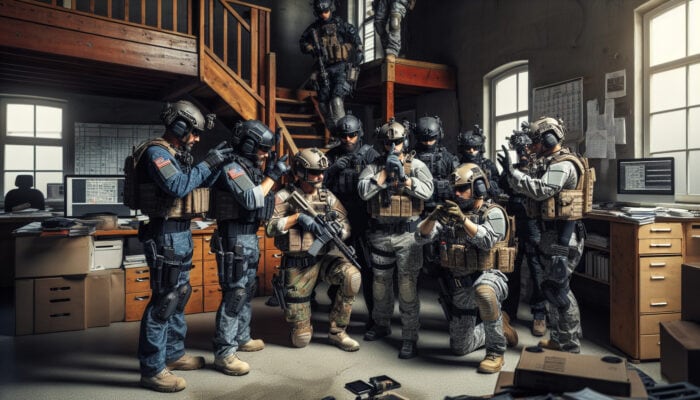Introduction to Multi-Team Coordination for House Clearance
What is Multi-Team Coordination?

Multi-Team Coordination for House Clearance: Multi-team coordination refers to the collaborative effort of multiple groups working together to achieve a common objective, specifically in the context of house clearance. This approach necessitates efficient communication, robust planning, and clear delegation of responsibilities among team members. Essential components of successful multi-team coordination include:
- Clearly defined roles and responsibilities
- Effective communication strategies
- Regular training and safety drills
- Utilisation of technology for real-time updates
- Regular feedback and improvement sessions
- Conflict resolution strategies
- Comprehensive planning and execution
- Safety protocols and compliance adherence
By harnessing these components, teams can operate cohesively, minimising disruptions and maximising productivity throughout the house clearance process.
The Importance of Coordination in House Clearance
Effective coordination in house clearance is paramount as it ensures the task is completed efficiently and safely. When teams work in harmony, the likelihood of delays and safety hazards decreases significantly. Proper coordination facilitates the smooth integration of various teams, enabling them to navigate challenges swiftly and efficiently.
Legal Requirements for House Clearance in the UK
House clearance operations in the UK must adhere to numerous legal requirements, including waste disposal laws and health and safety standards. Understanding these regulations is crucial for successful operations, as it helps mitigate legal repercussions and enhances overall operational integrity.
Expert Insights on Multi-Team Coordination for House Clearance

How Can Teams Be Effectively Structured?
Structuring teams effectively is fundamental to enhancing efficiency in house clearance projects. A well-defined hierarchy can streamline operations, with roles such as a lead coordinator overseeing the project, a safety officer ensuring compliance with health regulations, and a logistics manager coordinating the movement of items. For instance, in a recent large-scale clearance project in London, the clear division of responsibilities enabled teams to work autonomously while remaining aligned with the overall mission. Other successful structures include cross-functional teams, where individuals from various specialisations collaborate towards a common goal, maximising the utilisation of diverse skills and expertise.
Implementing a team structure not only improves efficiency but also fosters a culture of accountability. Each team member understands their specific responsibilities, leading to a more organised and cohesive effort. Regular assessments of team dynamics and roles can also improve performance over time.
What Are the Best Communication Tools for Teams?
Effective communication is critical for successful multi-team coordination in house clearance. Tools such as walkie-talkies and mobile applications, alongside regular briefings, can significantly enhance the flow of information. For example, using dedicated mobile apps designed for project management enables teams to share updates in real-time, track progress, and communicate issues as they arise.
Actionable steps to implement these communication tools include conducting an initial survey of team members to identify preferred methods of communication. After identifying these preferences, training sessions can be organised to familiarise teams with the chosen tools. Regularly scheduled briefings, combined with a digital communication platform, will ensure that all team members are aligned and can adapt quickly to changing circumstances.
How to Manage Conflicts Within Teams?

Conflicts can occur within teams due to differing opinions, work styles, or misunderstandings. Effective conflict resolution strategies are crucial for maintaining team harmony and productivity. Establishing an open dialogue where team members feel valued can significantly reduce tensions. Encouraging feedback and facilitating regular check-ins can help in identifying potential sources of conflict early on. When issues arise, it’s essential to address them promptly through mediating discussions that focus on collaborative solutions, ensuring that every voice is heard and respected.
How to Ensure Safety Across Multiple Teams?
The implementation of robust safety protocols is essential in multi-team house clearance operations. Regular safety drills, clear communication of potential hazards, and the assignment of dedicated safety officers to each team can significantly reduce the risk of accidents. In one instance involving a clearance project in Manchester, teams conducted weekly safety drills, which not only boosted team morale but also resulted in zero incidents during the operation.
Additional safety measures include providing personal protective equipment (PPE), establishing clear evacuation routes, and maintaining an effective emergency response plan. Continuous monitoring and evaluation of safety protocols, coupled with open communication about safety concerns, foster a culture of safety and awareness among all team members.
Key Steps in Multi-Team House Clearance Operations
What Are the Initial Planning Stages?
The initial planning stages of house clearance are vital for setting the foundation of successful operations. This phase involves a thorough assessment of the property, identifying potential hazards, and determining the necessary resources for the task. Engaging with property owners and stakeholders to understand their expectations and requirements is also crucial.
A comprehensive plan should encompass logistics such as timelines, workforce distribution, equipment needs, and waste disposal arrangements. By investing time in detailed planning, teams can avoid common pitfalls, ensuring a smoother execution phase. Furthermore, creating a contingency plan for unexpected challenges can bolster resilience, paving the way for successful outcomes.
Execution of House Clearance
The execution phase is where the theoretical planning translates into actionable performance. Teams must work in tandem to remove items, clean the property, and prepare it for its next use. Coordination during this phase is vital; teams must communicate effectively to minimise disruptions and ensure safety.
Regular team briefings during execution help keep everyone informed about progress and any emerging issues that may arise. Utilising project management software can facilitate the tracking of progress and the swift adaptation of plans as needed. The ability to adjust workflows on the fly significantly enhances efficiency and reduces the risk of delays.
Post-Clearance Procedures
After the clearance process, several critical post-clearance procedures must be followed to ensure the property is secure and compliant with all legal requirements. Teams should verify that waste is disposed of correctly and that all documentation related to the clearance is completed and filed appropriately.
A thorough walkthrough of the property is essential to ensure that no items are left behind and that all safety standards have been met. Engaging with the property owners to review the work completed and gather feedback is also a valuable practice that can enhance future operations and build trust.
What Are the Benefits of Multi-Team Coordination for House Clearance?
Increased Efficiency
One of the primary benefits of multi-team coordination is the increased efficiency it provides. By dividing the workload among various teams, each focusing on specific tasks, clearance times can be significantly reduced. For instance, while one team focuses on heavy lifting, another can manage logistics, leading to a streamlined process that accelerates overall completion time.
This division of labour not only speeds up the operation but also allows for a more organised approach. Teams can work on parallel tasks without stepping on each other’s toes, which ultimately enhances productivity and reduces the stress often associated with large-scale clearances.
Enhanced Safety Measures
In multi-team environments, implementing safety measures can be more thorough and effective. With dedicated safety officers for each team, there is a heightened focus on compliance with health and safety protocols. Regular safety briefings and drills foster a culture of preparedness, ensuring that all team members are aware of potential risks and how to mitigate them.
Moreover, the presence of multiple teams allows for constant supervision and monitoring of safety practices. This oversight can significantly reduce the incidence of accidents, creating a safer working environment for everyone involved in the house clearance.
Improved Resource Management
Coordination across multiple teams facilitates better resource management, resulting in cost savings and a more effective use of assets. By assessing resource needs upfront and allocatingworkforcer, equipment, and time accordingly, operations can run smoothly without unnecessary delays or resource wastage.
For example, during a house clearance project in Birmingham, effective coordination allowed for the utilisation of shared equipment among teams, which streamlined costs and maximised efficiency. This approach to resource management ensures that each team has what it needs to perform effectively while minimising excess expenditure.
Trusted Strategies for Multi-Team Coordination for House Clearance
How to Train Teams for Effective Coordination?
Training is a critical element in fostering effective coordination among teams engaged in house clearance. The training program should cover key areas, including communication protocols, safety guidelines, and the specific tasks each team will undertake. Regular drills and workshops can enhance team readiness and ensure that members are familiar with their roles.
Moreover, expert analysis indicates that scenario-based training, where teams practice responses to potential challenges, can significantly improve their ability to work cohesively under pressure. Ongoing training sessions can also serve as a platform for teams to discuss past experiences, share insights, and refine their strategies for future operations.
Implementing Technology in Coordination
Incorporating technology into multi-team coordination can significantly streamline operations. Project management software and tracking systems enable teams to monitor progress and make real-time adjustments to plans as necessary. For instance, using a cloud-based platform allows all team members to access updated information instantly, ensuring everyone is aligned.
Additionally, leveraging technology to manage schedules and logistics can reduce the risk of miscommunication and errors. By employing digital tools, teams can enhance their efficiency, leading to quicker and more effective house clearance operations.
Continuous Improvement and Feedback
Establishing a culture of continuous improvement is essential for enhancing multi-team coordination. Regular reviews and feedback sessions provide teams with the opportunity to reflect on their performance, identify areas for improvement, and implement changes based on lessons learned from previous projects.
This cycle of feedback and improvement not only boosts team morale but also leads to enhanced operational efficiency over time. Engaging team members in this process encourages ownership of their roles and cultivates a proactive approach to problem-solving.
Establishing Clear Roles and Responsibilities
Defining specific roles and responsibilities within each team is crucial to avoid confusion and overlap. Each team member must understand their tasks and how they contribute to the overall clearance process. This clarity fosters accountability and empowers team members to perform their duties effectively.
To establish clear roles, a detailed project plan should be created that outlines each team member’s responsibilities, ensuring that everyone is aware of their expected tasks. Regular check-ins can help reinforce these roles and provide opportunities for team members to discuss their experiences and challenges, fostering a sense of shared understanding and collaboration.
Effective Communication Channels
Utilising effective communication channels is vital for maintaining coordination among multiple teams. Tools such as radios, mobile applications, and regular briefings help ensure that all teams are aligned and can respond promptly to any changes or issues during the clearance operation.
Establishing a standard communication protocol will streamline information sharing and reduce the risk of miscommunication. Regular updates and briefings can also keep everyone informed of progress and emerging challenges, fostering a collaborative environment where all team members feel included and engaged in the process.
Case Studies of Successful Multi-Team House Clearance in the UK
Large-Scale Clearance Projects
Examining large-scale house clearance projects provides valuable insights into how multi-team coordination can effectively address complex clearances. For instance, a prominent project in East London involved the clearance of a substantial estate, requiring the collaboration of several teams. This case highlighted best practices, including regular coordination meetings, shared technology platforms, and thorough planning, that contributed to the project’s success.
Additionally, this case study highlighted the importance of flexibility, as teams were able to adapt to unexpected challenges by reallocating resources and adjusting timelines, ultimately completing the project ahead of schedule. Analysing such successful projects offers a roadmap for improving future multi-team operations.
Urban vs. Rural Clearance Challenges
Different environments present unique challenges for house clearance operations. Urban settings often present logistical hurdles, such as limited access for large vehicles and the need for permits, whereas rural areas may face accessibility issues due to their remote locations. For example, a rural clearance in the Cotswolds required careful planning to ensure that all necessary equipment could be transported to the site without complications.
Understanding these environmental challenges is crucial for teams to devise appropriate strategies. Urban clearances often benefit from enhanced communication with local authorities, while rural clearances may necessitate a focus on transportation logistics and alternative access routes.
What Lessons Can Be Learned from Past Projects?
Past house clearance projects offer invaluable lessons that can refine strategies for future multi-team operations—analysing what worked well and what did not can provide insights into improving coordination efforts. For instance, a case study from a clearance in Manchester revealed that early stakeholder engagement significantly improved timelines and stakeholder satisfaction.
Moreover, documenting lessons learned can create a repository of knowledge that teams can reference for future projects. This continuous learning mindset allows teams to adapt their approaches based on previous experiences, ultimately enhancing overall success rates and operational efficiency.
FAQs
What is the role of a lead coordinator in multi-team house clearance?
The lead coordinator oversees the entire house clearance operation, ensuring that all teams are aligned with project goals, managing resources, and facilitating communication between teams.
How can technology improve house clearance operations?
Technology enhances house clearance operations by streamlining communication, tracking progress in real time, and managing schedules effectively, leading to increased efficiency and reduced errors.
What safety protocols should be implemented during house clearance?
Safety protocols may include mandatory PPE use, regular safety drills, hazard communication, and having dedicated safety officers for each team to ensure compliance and risk minimisation.
How do you handle conflicts between team members?
Conflicts can be managed through open dialogue, mediation, and fostering a culture where team members feel safe expressing their concerns, thereby enabling constructive resolution.
What are the legal requirements for house clearance in the UK?
House clearance in the UK must comply with waste disposal laws, health and safety regulations, and local council guidelines to ensure legal compliance throughout the process.
How can regular feedback enhance team performance?
Regular feedback sessions foster a culture of continuous improvement, enabling teams to assess their performance, pinpoint areas for improvement, and implement changes for future operations.
What are the benefits of having a dedicated safety officer for each team?
A dedicated safety officer ensures that safety protocols are consistently followed, provides immediate guidance on safety issues, and enhances overall awareness of workplace hazards.
How important is initial planning in house clearance operations?
Initial planning is crucial for a successful house clearance, as it sets the foundation for operations, helping teams identify the resources, hazards, and timelines essential for effective execution.
What are the challenges of urban house clearance compared to rural clearance?
Urban house clearance often faces logistical challenges such as limited access and regulatory requirements, while rural clearance may encounter accessibility issues due to remote locations.
How does multi-team coordination impact operational efficiency?
Multi-team coordination enhances operational efficiency by allowing for the division of labour, enabling teams to focus on specific tasks simultaneously, which accelerates the overall clearance process.





